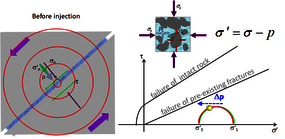Seismicity induced by geoenergy projects: review and simulation methods
Numerous geoenergy projects (geologic carbon storage, geothermal systems, gas storage or hydraulic fracturing) involve injection of fluids at depth. The resulting changes in stress often induce (micro)seismicity. While damages are usually minimal, public perception may be damaged, thus compromising the project viability. The problem is worsened by the numerous processes involved (hydraulic, mechanical, thermal, and often chemical), by the fact that they are intimately coupled, and by the diversity of failure settings. As a result, understanding is hard, which hinders not only numerical simulation, but also the design and operation of remediation and mitigation actions. We first review coupled process, from the traditional impact of pore pressure increase on stability, to stress transfer driven by pressure gradients or thermal contraction. This leads to a broad view of the induced seismicity operational mechanisms, which we summarize in five operational failure mechanisms (i.e., directly linked to fluid operation): pressure buildup, pressure dissipation, displacement transfer, thermal contraction, and buoyancy. Understanding them is needed to move beyond the traditional traffic light system into active pressure management to control induced seismicity.

